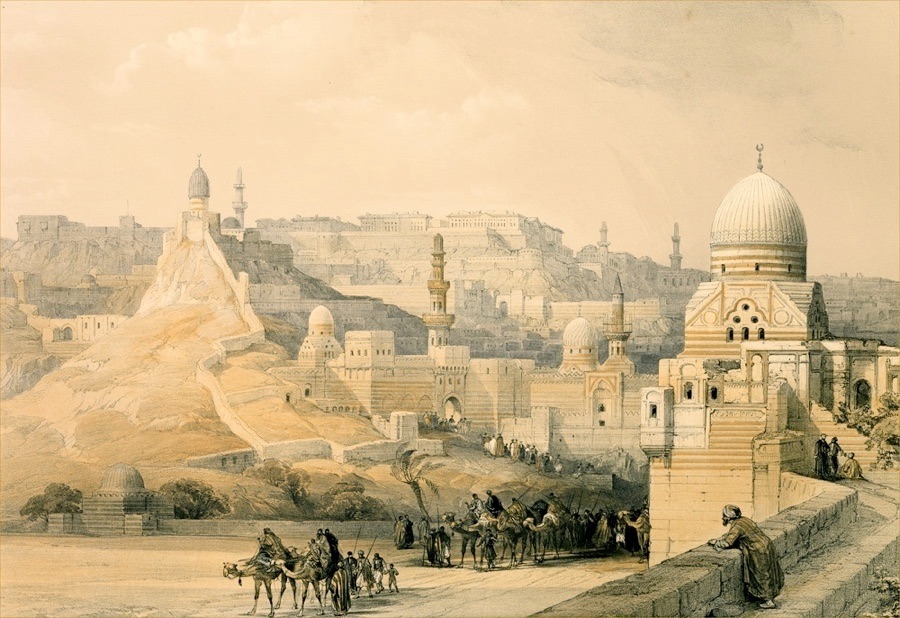CITADEL OF CAIRO, THE RESIDENCE OF THE PASHA
THIS striking view is taken from a ruined mosque near the city walls, and looking towards the rock of the Citadel, which stretches along the horizon, from where it intercepts the range of the distant Moccatam hills to the great mosque of the Sultan Hassan. Between the observer and the hill of the Citadel lies the great necropolis of Cairo, that part of the eastern desert which extends from its walls to the Moccatam range, in which the dead of ages are laid, and where those splendid religious edifices are found which are commonly called the Tombs of the Sultans. The ruined mosque in the foreground is built in an angle of the city wall. From one of the gates below a caravan is seen issuing, and masses of building which intervene between the ruined mosque and the Citadel are broken by the domes and minarets of the mosques of Cairo.
The Citadel itself is covered with a range of buildings, that present in this view rather the appearance of a barracks than the palace and mosque of the Pasha, where he holds his court, though his domestic residence is in the Isle of Shoubra.
The fortress of the Citadel is, however, very strong, and is erected upon a promontory or spur of the Moccatam hills, which forms a table two hundred feet above the plain of the city, and completely commands it; it is strongly fortified, especially towards the city. The Saladin of history and of romance was its founder; he built its defences in the twelfth century, and manfully opposed Richard Cœur de Lion and Philip Augustus. The French, during their occupation of Cairo, fifty years ago, strengthened the fortifications by outworks; and Mehemet Ali has still further improved its defences. He also built the splendid palace and hareem which are seen on the right cresting the hill. The Citadel is the lofty building which on the left of the range intercepts the more distant Moccatam. The minaret of the old or great mosque rises between the Citadel and the palace; and another great mosque, now erecting, is intercepted by the dome of the ruined mosque in the foreground.
The new palace is magnificent and capacious, combining the splendour of the East with all the luxuries of Europe which he could command. Gorgeous chandeliers from England and mirrors from France; plate-glass in such profusion that the windows of the state-apartments are triply glazed to keep out the sand of the Desert. The ceilings are painted in fresco, the marbles of Italy are employed in the decoration, and gorgeous carpets from England form the furniture of this vice-regal residence.
The Hall of Audience is a noble apartment one hundred and fifty feet long, and one hundred and twenty wide, paved with marble. Besides the palaces, there is a mosque, not yet completed, which is intended to surpass all others in Cairo. Within the Citadel are many public offices,- the Mint, the Hall of Justice, and the Arsenal. To make room for the mosque, the famous Hall of Joseph, a lofty building supported on numerous handsome granite columns, was removed in 1829; a few of the columns only are yet standing, but those which formerly stood there were so carelessly removed that by far the greater number were broken- a fate that probably awaits the removal of the remainder.
There are still some remains of the palace of Saladin, and the fine minaret of his mosque remains, but the ruined palace is used as a weaving manufactory! On the Citadel is a relic of the great Saladin, not so easily destroyed or misappropriated, it is known as Joseph's Well, which is sunk in the solid rock to the depth of two hundred and eighty feet, and is forty-two feet in circumference. A winding gallery, which mules can ascend and descend, reaches to the water; this well renders the Citadel independent of the aqueduct from the Nile.
It may be easily imagined how very fine the view of Cairo and the surrounding country must be from those accessible points of the Citadel which complete a panoramic survey, especially from the platform, where the city is seen below the observer, with its thousand minarets and domes; and the valley of the Nile is commanded from the Great Pyramids and those of Saccara on the south, and towards the north, to its subsidence into the Delta.


